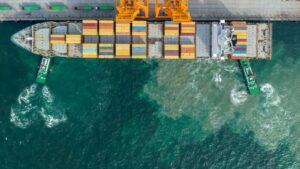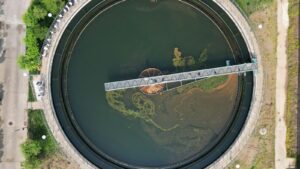Agtech Inspiration – From Desert to Fertile Land: Desert Control Makes the 2020 50 to Watch List
 Despite taking a backseat to the health crisis in the last few months, climate change increasingly shapes our daily experience through wildfires, droughts, hurricanes and pollution. In the face of this worsening crisis, we are witnessing the rise of a new generation of innovators creating technologies and business models that could solve the plastics crisis, regenerate soils, seed new forests, create climate-positive buildings and end desertification. Now in its second year, Cleantech Group’s 50 to Watch list recognizes these extraordinary trailblazers fighting the good fight, for all of us.
Despite taking a backseat to the health crisis in the last few months, climate change increasingly shapes our daily experience through wildfires, droughts, hurricanes and pollution. In the face of this worsening crisis, we are witnessing the rise of a new generation of innovators creating technologies and business models that could solve the plastics crisis, regenerate soils, seed new forests, create climate-positive buildings and end desertification. Now in its second year, Cleantech Group’s 50 to Watch list recognizes these extraordinary trailblazers fighting the good fight, for all of us.
Interview With a New 50 to Watch Company
We are thrilled to announce that Desert Control will appear on our 2020 50 to Watch list. The complete list will be out on 23 October. Desert Control has developed a combination of clay and water that can be sprayed on sandy soil to turn it into fertile land. We talked to Ole Kristian Sivertsen, its CEO andCo-founder to hear more.
What global challenge made you want to start Desert Control?
Ole Kristian: “Desertification is a major global challenge. Each year, we lose 12 million hectares of soil to sand, or three times the size of Denmark, affecting millions of people. On the other hand, global agriculture consumes more than 70% of all available freshwater in the world, and desertification is leading some regions to water overuse just to keep up. Our innovation, fundamentally, creates hope and delivers solutions to make this planet greener and more resilient.”
How did you come across the solution you are developing?
“As an inventor, I came across articles by Egyptian scientists looking at how the Nile Delta regressed and degraded. It was linked directly to the 1960s when a dam was built on the River Nile and all the areas downstream started to regress. There was a direct link with the clay and salt minerals that the river once brought, and it became clear that clay-rich soils retain more water and have a much higher resilience to droughts and high temperatures.
We had an idea to basically see if we can make a mechanical unit that can process clay into a liquid, that is just as thin and controllable as water without using any chemicals. If this could then be irrigated onto the topsoil without leaving a crust of clay on the top, we may have solved the problem.”
How did you develop this idea into a workable solution?
“We have had a lot of obstacles trying to turn this into a reality without using any chemicals. How can we control the particle size and therefore the surface area and structure of the clay flakes in the liquid? How can we make it homogeneous so that it does not leave any lumps? We had to figure out the algorithms and recipes that work, then adapt those to each specific area, as deserts are a complex ecosystem with varying biodiversity and soil types.
Such soil-based solutions need a complete cycle between each re-run or debugging, and multiple years of validation to ensure the solution works as expected and doesn’t have any negative impact on the ecosystem. Despite these challenges, we managed to secure angel investment and fund third party validations through independent research organizations.”
Can you give an example of a recent deployment, and how the solution works on the ground?
“We recently tested the Liquid NanoClay (LNC) to reclaim desert land into arable land and enable open field agricultural crop cultivation. Since increases in the soil’s water holding capacity boosts the survival rate of seeds and seedlings, we ended up only requiring a third of the amount of seeds we were expecting per square meter. A couple of weeks later, the plot had overdeveloped, and we actually had to take a lot of the seedlings out!”

Before and after. Source: Desert Control
“We have also worked on the validation of the liquid itself. For this, we treated an area around 1,000 square meters, and tested our batch production equipment. We split this area into 144 smaller test plots and are testing different variations of the LNC solution with a reference plot, for about two weeks.”
Once the process and solution has been validated, how would a typical project work?
“Our current focus is on building more effective equipment to produce larger volumes of the liquid clay. To give you some context, it takes us a week to treat a 1,000 square meters with the current prototype equipment. We could scale that and deploy quicker if we had let’s say 100,000 units, but that’s not a sustainable way to scale, as costs will skyrocket. So, we are building a scaled-up machine, that can produce up to 40,000 liters in around an hour. This means we will be able to treat 5 hectares per day, and we have the design for and high capacity unit that has 10 times this capacity.”

Pearlmillets, four weeks after LNC treatment. Source: Desert Control
“We will not be using large centralized factories, and then shipping the product around the world due to the accompanying environmental footprint. Instead, we are developing mobile processing units. We’d first look at a soil sample and figure out the optimal formulation of the LNC, and then bring in the unit to the site to produce the solution. The clay and water will be sourced locally, where possible. If possible, we can make use of an existing irrigation system to apply the solution to the land.
The solution is typically applied around 10 to 20cm below the main root zones and works by forming aggregates between the clay and soil. These structures help retain water and prevent leaching of nutrients. This typically takes around seven hours, after which you can start planting. The treatment is viable for at least five years; even longer if combined with sustainable land management practices.”
Who are your initial target customers?
“We are targeting three main segments for now. The first is green landscaping, where our aim is to help reduce water consumption and reduce the use of fertilizers. The second is in agriculture, for both food production and forestry, where we target farmers with established areas looking to improve their yield and reduce the risk of deforestation, as well as brown fields that need to be converted into fertile land. The third are NGOs and multi-stakeholder initiatives that are promoting impact programs.
To give an example, we had some very positive discussions with the UN around our solution and what it offers. The Greenbelt project across the African continent, for example, is a reforestation project where we would have a wall of trees running throughout. This should not only be about planting trees, but creating a sustainable and environment for all involved.”
What does success look like to you in five years?
“Looking ahead five years, we hope to have made significant success in all three of our focus segments and gained a lot of philanthropic attention to start funding some of the larger impact initiatives. Having a lot of community engagement and customers is one of our strongest reference metrics.”

Harvesting watermelons. Source: Desert Control
“We do not want to contribute to increasing food and water security alone, but also play a role in reducing carbon emissions and creating local jobs around the world. We will start off by delivering turnkey solutions, and then move onto semi-autonomous business units around each mobile factory. Currently, our cost to deploy is around $2 per square meter, which is somewhat expensive especially in developing areas. We could finance these through multi-stakeholder initiatives, but for a normal farmer this might not be viable. We are betting on scale to reduce overall cost to around $0.20 per meter in a five-year time-frame.”
Was there something along the way almost made you quit?
“The invention process had many up and downs, with extensive trial and error and frustration involved, but we are undeterred. Our whole purpose is to contribute to something significant, to go beyond shareholder value and create value for all stakeholders involved, including the planet. We want to instill hope and inspiration in communities, and bring solutions forward that work for both the planet and these communities.”


